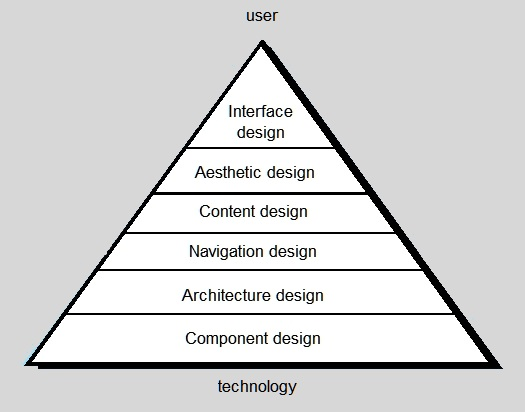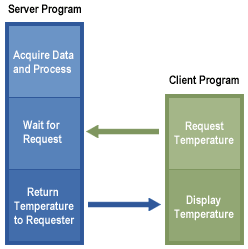Section 0: Module Objectives or Competencies
| Course Objective or Competency | Module Objectives or Competency |
|---|---|
| The student will be able to explain the differences between web-based systems and conventional systems. | The student will be able to explain the characteristics of web-based systems. |
| The student will be able to explain the features of web-based systems. |
Section 1: Characteristics of Web-based Systems
Object-Oriented and Classical Software Engineering, 8th Edition by Schach, provides the following characteristics of web-based systems:
-
Unstable requirements
- The moving target problem tends to be more acute in the case of Web software, because there are three moving targets: the members of the community of users, the experience level of the users, and Web technology. Accordingly, the requirements of Web software tend to change rapidly.
-
Wide range of user skills
- The skill set of a Web user can range from total beginner to expert. This can have major implications for the design of the human computer interface.
- No opportunity to train users
- When a new software product is installed in an organization, management can require every employee who is to use the product to undergo appropriate training. This is not possible with Web applications. At best, a help menu can be provided.
-
Varied content
- The website of an online retailer can contain text, graphics, audio, and video. Furthermore, these elements may be integrated with the all-important sales functionality of the website. This can drastically affect response times.
-
Exceedingly short maintenance turnaround times
- The time between releases of new versions of commercial software is typically six months or a year. In contrast, Web software can be updated as often as daily. Furthermore, updating can often be performed in the background, that is, seamlessly to the user.
-
The human user interface is of prime importance
- A poorly designed human computer interface for a software product can lead to increased learning times and higher error rates. In the case of Web software, a poorly designed human-computer interface can lead to the site in question being ignored by users, with severe financial consequences for the owner of the website.
-
Diverse run-time environments
- It should be possible to successfully access a given Web page using any of the many popular Web browsers. These browsers run on different hardware (including the PC and the Macintosh) under different operating systems (Linux. Mac OS X. Windows, and so on). Web software must be compatible with all these combinations of browsers, hardware, and operating systems.
-
Privacy and security requirements are usually stringent
- When a hacker breaks into an online database containing unencrypted credit card data, millions of credit card holders can be exposed to identity theft.
-
Accessibility through multiple devices
- The Web can be accessed via computer, cell phone, and so on. Web software must take this multiplicity of devices into account.
Section 2: Features of Web-based Systems
Do the attributes of web applications differ from those of conventional software?
- Some people argue that a web application is nothing more than a client-server application with a heavy emphasis on both functionality and aesthetic presentation (e.g., layout, graphics, audio and video elements) and that both web applications and conventional client-server applications have the same attributes.
- The most frequently mentioned “new” aspect of development of web-based applications is the extreme pace under which the work must be conducted.
- Standards are evolving, few well-organized working routines exist, and many new competence groups are involved.
- Much development of web-based applications seems to be characterized by very vague requirements.
- Internal quality regarding the design of databases, the internal architecture, and the code are not in focus; rather the system as a visual artifact and the aesthetics and usability become essential.
- Hence, most developers think that when considered in their totality, a complete set of web application characteristics do differentiate web-based systems from more conventional computer-based systems.
The following attributes are encountered in the vast majority of web applications.
- Network intensiveness
- Webapps are hosted on some type of networked system like the Internet in order to be available to as many users as possible.
- Every webapp resides on the Internet (thereby enabling open worldwide communication), an intranet (implementing communication across an organization), or an extranet (internetwork communication) to meet the needs of diverse groups of users.
- Concurrency
- A large number of users may access the webapp at one time.
- In many cases, the patterns of usage among end users will vary greatly.
- In some cases, the actions of one user or one set of users may have an impact on the actions of other users or the information presented to other users.
- Unpredictable load
- The number of users of the webapp may vary by orders of magnitude from day to day.
- The webapp must be capable of handling an indeterminate number of events simultaneously.
- Performance
- If a webapp user must wait too long (for access, for server-side processing, for client-side formatting and display), he or she may decide to leave the site.
- Availability
- Although an expectation of 100 percent availability is unreasonable, users of popular web applications often demand access on a "24/7/365" basis.
- The web application must be designed to achieve this ideal (or something very close to it).
- Data driven
- The primary function of many web applications is to use hypermedia to present text, graphics, audio, and video content to the end user.
- In addition, web applications are commonly used to access information that exists on databases that are not an integral part of the web-based environment (e.g., eCommerce or financial applications).
- Content sensitive
- The quality and aesthetic nature of content remains an important determinant of the quality of a web application.
- Continuous evolution
- Unlike conventional application software that evolves over a series of planned, chronologically spaced releases, web applications evolve continuously.
- It is not unusual for some web applications (specifically, their content) to be updated on a minute-by-minute schedule or for content to be independently computed for each request.
- Immediacy
- Although immediacy – the compelling need to get software to market quickly – is a characteristic of many application domains, web applications often exhibit a time-to-market that can be a matter of a few days or weeks.
- Web developers must use (agile) methods for planning, analysis, design, implementation, and testing that have been adapted to the compressed time schedules required for web application development.
- Security
- Because web applications are available via network access, it is difficult, if not impossible, to limit the population of end users who may access the application.
- In order to protect sensitive content and provide secure modes of data transmission, strong security measures must be implemented throughout the infrastructure that supports a webapp and within the application itself.
- Aesthetics
- An undeniable part of the appeal of a webapp is its look and feel.
- When an application has been designed to market or sell products or ideas or provide services that generate revenue, aesthetics may have as much to do with success as technical design.
- Usability
- Web usability refers to the ease of use of web-based systems, including the presentation of information and choices in a clear and concise way, a lack of ambiguity and the placement of important items in appropriate areas.
- One important aspect is ensuring that the content works on various devices and browsers.
There are additional characteristics of web-based systems that differentiate them from conventional systems:
- Internet time – events occur at a faster rate on the Internet than elsewhere
- Strategic implication
- Emphasis on graphical user interface
- Customer orientation
- Users with unknown background and equipment
- Communication among various stakeholders
- Content is essential, both its structure and essence
- Navigation is a key issue
Section 3: Web Design Pyramid

Web Design Pyramid






